Choosing the right parrot food can make all the difference in your bird’s health, happiness, and energy levels. Parrots aren’t just pets—they’re intelligent, vibrant companions that thrive on a balanced and varied diet. Whether you’re a first-time bird owner or a seasoned parrot parent, knowing what to feed your feathered friend is key to keeping them chirping with joy every single day.
In this guide, you’ll discover everything from top-rated commercial bird pellets to fresh fruits and vegetables that your parrot will love. We’ll also explore species-specific needs, homemade parrot food ideas, and practical feeding tips to support a long, healthy life. Get ready to build a daily diet your parrot will not only enjoy but truly benefit from.
Understanding Parrot Nutrition Basics
The Importance of a Healthy Parrot Diet
Feeding your parrot a healthy, well-balanced diet goes far beyond simply filling up a food dish. A parrot’s diet directly affects its mood, feather condition, immune system, and even its ability to vocalize and interact with you. Many health issues in parrots, including obesity, feather plucking, and vitamin deficiencies, stem from poor nutrition. When you make smart, informed choices about parrot food, you give your bird the tools it needs to thrive. A healthy diet packed with fresh produce, high-quality pellets, and occasional treats can support your parrot’s physical energy and mental stimulation. Think of nutrition as one of the most powerful forms of care you can provide—it’s the daily fuel that keeps your companion joyful and active.
What Do Parrots Eat in the Wild vs. at Home
Parrots in the wild spend a large part of their day foraging for food. Their diet includes a wide variety of items such as seeds, nuts, fruits, berries, flowers, bark, and sometimes even insects or mineral-rich clay to aid digestion. This constant variety keeps their bodies balanced and their minds stimulated.
When you bring a parrot into your home, it no longer has access to the rich, ever-changing diet it once had in the wild. That’s where you come in. As a parrot owner, you need to mimic that diversity through a carefully planned selection of foods. Offering a mix of high-quality parrot food, fresh fruits, leafy greens, and occasional nuts can help bridge the gap between the wild and domestic environment. The more variety and color you include in their meals, the closer you come to honoring their natural instincts.
Key Nutrients for Parrots: Protein, Calcium, Fiber, and More
Parrots require a spectrum of essential nutrients to maintain good health throughout their lives. Protein is critical for building strong muscles and healthy feathers, especially during molting periods. Calcium plays a vital role in keeping bones strong and is particularly important for female parrots during egg-laying. Fiber supports digestion and helps prevent issues like crop impaction and obesity. Vitamins and minerals—from vitamin A for vision and skin to magnesium for nerve function—complete the picture.
A high-quality parrot food blend usually includes a good base of these nutrients, but it’s your job to enhance that base with fresh, natural foods. Dark leafy greens, carrots, bell peppers, beans, and even cooked quinoa or brown rice can all serve as excellent nutritional boosters. By understanding what each nutrient does and where to find it, you give your parrot a well-rounded, species-appropriate diet.
The Role of an Avian Vet in Your Bird’s Diet Plan
Just like humans benefit from personalized medical advice, parrots need expert care when it comes to their diet. An avian vet can offer insights that go far beyond general feeding advice. During checkups, the vet can assess your parrot’s weight, feather condition, and blood nutrient levels to catch early signs of dietary imbalances. They can also help you fine-tune your feeding routine if your parrot is aging, recovering from illness, or showing changes in appetite or behavior.
For example, if your bird is becoming overweight or lethargic, an avian vet may recommend adjusting portions or switching brands of parrot food that are better suited to your bird’s specific needs. They also stay updated on species-specific requirements, ensuring your African Grey, Amazon Parrot, or Cockatoo gets exactly what it needs to live a long and vibrant life. Regular vet visits take the guesswork out of feeding and give you peace of mind that you’re doing the best for your feathered friend.
Best Commercial Parrot Food Options
Overview of Bird Pellets for Parrots (Pros & Cons)
Bird pellets have become a popular choice among parrot owners who want to provide a nutritionally balanced diet. Unlike seed mixes, which can be high in fat and encourage selective eating, pellets offer a uniform blend of essential nutrients in every bite. Most brands design their pellets to include protein, calcium, fiber, and vital vitamins and minerals. This consistency helps ensure your parrot gets the nutrition it needs, even if it’s a picky eater. However, pellets aren’t perfect. Some parrots resist the texture or flavor, especially if they’ve been raised on seeds. And while convenient, pellets lack the variety and natural enrichment that come from fresh foods. That’s why many owners use pellets as the foundation of their parrot food routine, then supplement with fruits, veggies, and occasional seeds for a more complete, engaging diet.
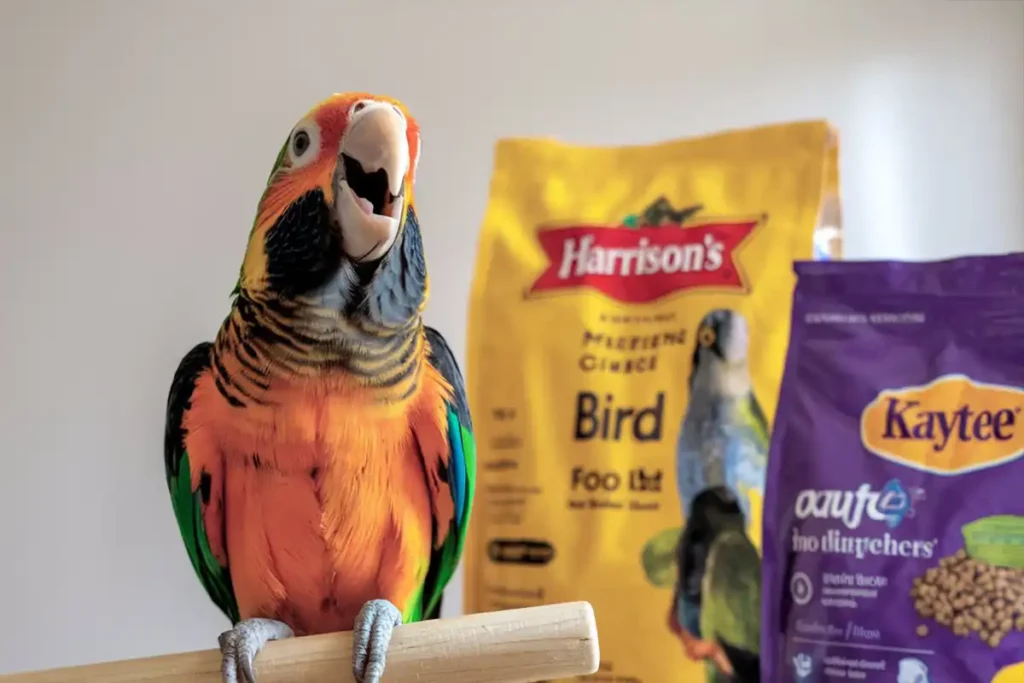
Top Bird Feed Brands: Harrison’s, ZuPreem, Kaytee
When choosing the best commercial parrot food, the brand you select makes a big difference. Harrison’s, for example, uses organic, non-GMO ingredients and avoids artificial preservatives, making it a trusted choice for parrots with sensitive systems. ZuPreem offers a wide range of formulas tailored to different species and dietary needs, including fruit blends that appeal to picky eaters. Kaytee provides both pellets and seed-based options, which can be helpful for owners transitioning their birds from seed-only diets. These brands invest in avian nutrition science and focus on quality control, ensuring your parrot receives safe, consistent, and nutrient-rich meals. No matter which one you choose, always match the formula to your parrot’s species and size to ensure the food meets its specific requirements.
Choosing the Right Parrot Food for African Grey, Amazon Parrot, and Cockatoo
Each parrot species has its own unique dietary needs, and understanding those differences helps you make better feeding decisions. African Greys, for instance, are prone to calcium deficiencies, so they benefit from calcium-rich foods and fortified pellets. Amazon Parrots tend to gain weight easily, so they require a lower-fat diet with a careful balance of protein and fiber. Cockatoos often struggle with emotional eating and can overindulge if not monitored closely, so variety and portion control are key. You need to choose parrot food that fits not just your bird’s species but also its age, activity level, and overall health. By tailoring your food choices to your parrot’s specific needs, you help prevent common health issues and support long-term vitality.
Seed vs Pellet Debate: What’s Better for Long-Term Health?
The debate between feeding seeds or pellets has divided parrot lovers for years, and both sides offer valid points. Seeds are natural and loved by most parrots, but they’re often high in fat and low in essential nutrients. Parrots that eat mostly seeds can develop nutritional imbalances, obesity, and even liver disease over time. On the other hand, pellets are formulated to provide complete nutrition in every bite but can lack the mental stimulation and natural variety parrots crave. The ideal long-term solution often lies in combining the best of both worlds. Offer a high-quality pellet as the main parrot food, then mix in small amounts of seeds, fresh fruits, vegetables, and occasional nuts. This hybrid approach keeps your bird both physically nourished and mentally engaged, striking the perfect balance between health and enjoyment.
Fresh and Homemade Food Choices for Parrots
Bird-Safe Fruits and Vegetables to Include
Fresh fruits and vegetables play a huge role in keeping your parrot’s diet colorful, natural, and nutrient-rich. Not every fruit or veggie is bird-safe, though, so it’s important to know which ones to offer. Parrots can safely enjoy apples (without seeds), bananas, berries, mangoes, and melons. On the veggie side, go for leafy greens like kale, romaine, and spinach, along with carrots, sweet potatoes, bell peppers, broccoli, and zucchini. Always wash produce thoroughly and cut it into manageable pieces. Avoid anything toxic like avocado, onion, garlic, and rhubarb. By adding a daily mix of safe, fresh produce to your parrot food routine, you not only boost nutrition but also give your parrot new textures and flavors to explore—which keeps them mentally stimulated and excited to eat.
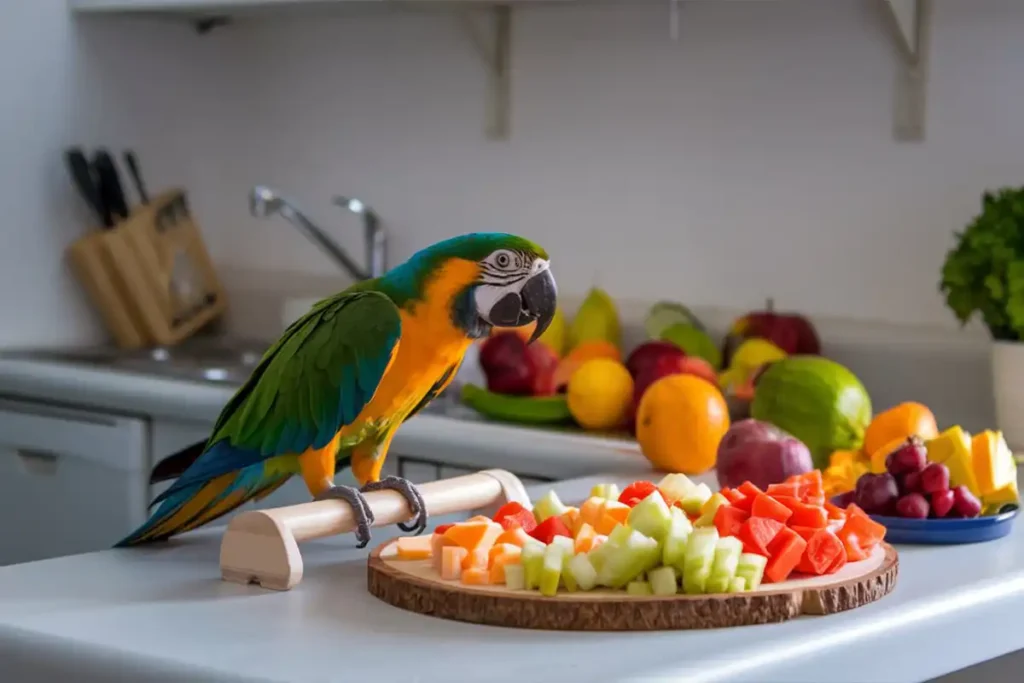
Healthy Homemade Parrot Food Ideas
Making parrot food at home gives you total control over the ingredients and allows you to tailor meals to your bird’s preferences and nutritional needs. You can whip up simple, healthy recipes using whole grains like quinoa, brown rice, or barley as a base. Mix in chopped veggies, cooked legumes like lentils or black beans, and a sprinkle of seeds or finely chopped nuts for added variety. Baked birdie bread made with whole grain flour, mashed sweet potato, and shredded greens is another great option for homemade treats. Just be sure to avoid added salt, sugar, and spices. Creating your own parrot food not only gives you peace of mind but also strengthens the bond between you and your bird through shared routines and mealtime excitement.
Creating a Balanced Feeding Schedule with Fresh Items
Parrots thrive when they follow a consistent and balanced feeding schedule. Start your bird’s day with fresh fruits and vegetables, as they provide a burst of hydration and nutrients that kickstart digestion. Later in the day, you can offer pellets or your bird’s favorite homemade mix to round out their nutritional intake. If you serve seeds or nuts as treats, do so in moderation and during training or enrichment sessions. Timing matters—remove any uneaten fresh food after a couple of hours to prevent spoilage. A well-planned feeding schedule ensures your parrot gets the most out of its diet without overeating or missing essential nutrients. When you treat fresh items as a key part of your parrot food plan and not just extras, you build a diet that supports long-term health and consistent energy.
Vitamin and Mineral Boosters from Natural Sources
You don’t always need supplements to boost your parrot’s intake of vitamins and minerals—nature already provides plenty of great options. Orange and dark green vegetables like carrots, squash, and kale are packed with vitamin A, which is vital for eye health and immunity. Fruits like papaya and kiwi offer vitamin C, while foods like almonds (in small, bird-safe amounts) and sunflower seeds provide vitamin E and healthy fats. For calcium, try offering broccoli, dandelion greens, or even a cuttlebone as a natural source. These whole foods can elevate the nutritional profile of any parrot food routine without relying on synthetic additives. When you rotate these nutrient-rich items into your parrot’s meals, you help prevent deficiencies and support vibrant feathers, strong bones, and a sharp mind.
Feeding Tips for a Happy, Healthy Parrot
Setting Up a Consistent Feeding Schedule
Parrots thrive on structure and predictability, especially when it comes to mealtimes. Setting up a consistent feeding schedule not only helps your bird feel secure, but also makes it easier to monitor how much and when it’s eating. Start the day by offering fresh fruits and vegetables in the morning, when your parrot is most alert and likely to eat well. Then provide pellets or a high-quality homemade parrot food blend in the afternoon or early evening. Remove uneaten fresh items after a couple of hours to keep the feeding area clean and avoid spoilage. By keeping feeding times consistent, you help your parrot develop healthy eating habits and prevent boredom-driven snacking or overeating. A clear routine builds trust and reinforces positive behavior around food.
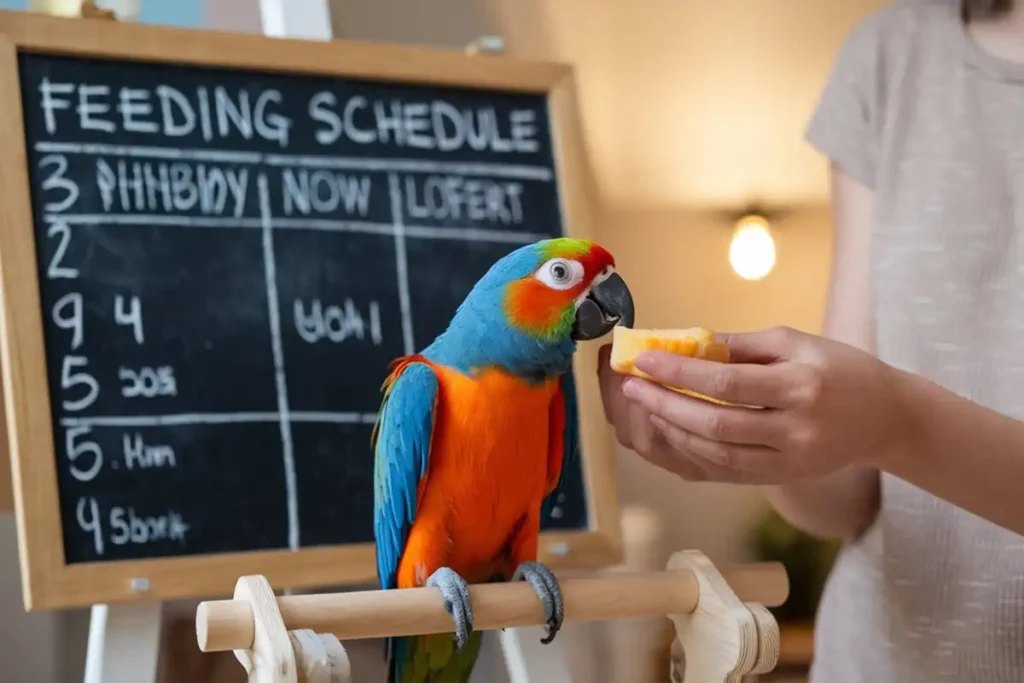
Monitoring Weight and Appetite Changes
Tracking your parrot’s weight and appetite can reveal important clues about its health. Sudden weight gain or loss, a drop in appetite, or changes in the way your bird eats could signal a nutritional imbalance or underlying illness. Weigh your parrot regularly using a small digital scale made for birds and record the results in a journal or app. Watch for signs like picking through food without eating, ignoring favorite treats, or dropping food more than usual. These changes might indicate that your parrot food routine needs adjustment. If something seems off, don’t wait—contact your avian vet for a checkup. Staying observant and proactive ensures that you catch problems early and adjust your bird’s diet before they become serious.
How to Transition Parrots to New Foods Safely
Parrots don’t always take kindly to change, especially when it comes to what’s in their food bowl. If you need to introduce a new parrot food—whether switching brands, adding pellets, or incorporating fresh items—do it gradually. Start by mixing a small portion of the new food with your bird’s current diet. Over the course of 1 to 2 weeks, slowly increase the amount of the new food while decreasing the old. Keep an eye on your parrot’s droppings, appetite, and behavior during the transition. Use positive reinforcement, like praise or playtime, to encourage curiosity about the new food. Patience is key. Forcing a sudden change can lead to stress, food refusal, or even nutritional setbacks. A gentle, step-by-step approach helps your parrot accept and eventually enjoy new foods as part of its daily diet.
Common Feeding Mistakes and How to Avoid Them
Even the most well-meaning parrot owners can make feeding mistakes that affect their bird’s health. Over-relying on seeds is one of the most common issues—while parrots love seeds, they’re high in fat and lack essential nutrients. Offering them as treats is fine, but they shouldn’t make up the bulk of your parrot food plan. Another mistake is offering too many sugary fruits without balancing them with vegetables and protein-rich items. Feeding table scraps or foods with salt, sugar, or spices is also dangerous, as many human ingredients are toxic to birds. Skipping fresh foods entirely can lead to deficiencies and boredom. To avoid these pitfalls, stick to species-appropriate foods, rotate fresh produce regularly, and use measured portions. With a little knowledge and attention, you can build a safe, nourishing, and exciting diet your parrot will love.
Parrot Food Guide by Species
African Grey Parrot Diet Needs
African Grey Parrots are intelligent, sensitive birds with unique dietary needs that support their health and mental well-being. These parrots are especially prone to calcium and vitamin A deficiencies, so you’ll need to focus on nutrient-rich foods that meet those requirements. Fresh leafy greens like kale, collard greens, and dandelion leaves offer excellent sources of calcium and should appear regularly in their meals. Orange vegetables like carrots, sweet potatoes, and pumpkin supply beta-carotene, which converts to vitamin A in the body. Supplementing with high-quality parrot food that’s specifically formulated for African Greys ensures your bird gets the proper balance of protein, fiber, and minerals. Include a variety of fruits and pellets as well, but avoid high-fat foods like too many nuts, which can contribute to weight gain or liver stress. By catering to their specific nutritional needs, you help your Grey stay sharp, energetic, and vibrantly feathered.
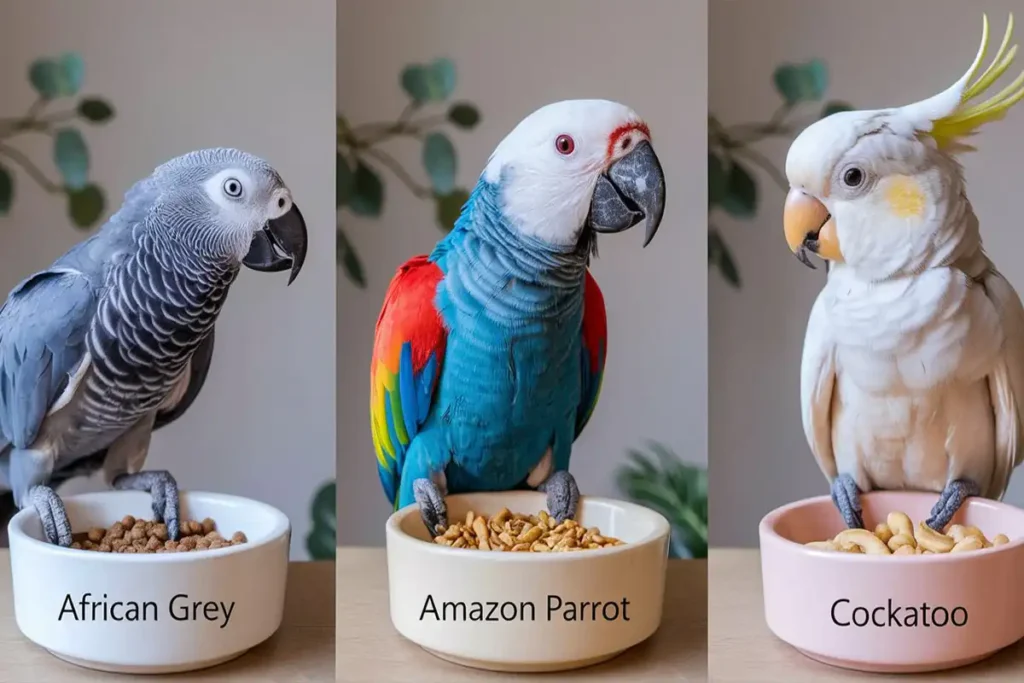
Feeding an Amazon Parrot the Right Way
Amazon Parrots are playful, vocal, and full of personality—but they also have a tendency to gain weight easily. That’s why feeding them requires careful portion control and a focus on low-fat, high-fiber foods. Instead of giving them seed-heavy diets, which can quickly lead to obesity, start with a base of high-quality pellets and build around that with fresh vegetables, fruits, and occasional legumes. Offer cooked beans, broccoli, leafy greens, bell peppers, and a variety of squashes to keep their meals colorful and diverse. While fruits like apple, mango, and berries are fine in moderation, limit sugary treats to just a few times a week. The right parrot food for Amazons should keep them full, active, and mentally stimulated without tipping the scale. Keep an eye on their weight and energy levels, and adjust the balance between pellets and fresh foods as needed.
Cockatoo-Specific Nutrition Tips
Cockatoos are affectionate and often demand more attention and emotional engagement than many other parrot species. Their nutritional care should match that level of attentiveness. Cockatoos are prone to obesity and fatty liver disease, especially when they consume too many seeds or nuts. That’s why a large portion of their diet should come from vegetables, high-fiber greens, and carefully measured pellets. Cooked sweet potatoes, carrots, bok choy, zucchini, and broccoli make great staples. Fruits should be offered sparingly, mainly as training rewards or occasional treats. It’s important to keep feeding routines consistent and use foraging toys to add enrichment to their eating habits. Cockatoos also benefit from a little extra protein during molting or breeding seasons—cooked quinoa, lentils, or a small amount of egg can help. Choosing the right parrot food for Cockatoos involves more than nutrition—it’s about providing meals that align with their emotional and physical needs.
Adjusting the Diet for Age, Activity, and Health Conditions
Your parrot’s diet should evolve over time as it grows, becomes more or less active, or faces specific health conditions. Younger parrots need more protein and calcium to support bone development and feather growth, while older birds may require fewer calories but more antioxidants to support aging organs. Active parrots burn more energy and need a diet rich in whole grains and healthy fats, while more sedentary birds benefit from low-fat meals and fiber-rich vegetables to maintain a healthy weight. If your bird develops a health issue, like kidney disease or vitamin deficiencies, an avian vet can recommend adjustments to your parrot food plan—such as limiting phosphorus or boosting vitamin A intake. Always observe changes in your bird’s weight, feather quality, or energy levels. Being flexible and proactive about diet helps you support your parrot’s well-being at every stage of life.
Conclusion
Feeding your parrot isn’t just about filling a food bowl—it’s about building a foundation for a long, vibrant, and happy life. By choosing the right parrot food, you support not only your bird’s physical health but also its mental and emotional well-being. Every parrot has unique needs based on its species, age, and personality, and tailoring your parrot’s meals to those factors can make a noticeable difference in their energy, behavior, and feather quality.
Start by offering a mix of high-quality parrot food brands like Harrison’s, ZuPreem, or Kaytee as a base. Supplement those with bird-safe fruits and vegetables, healthy homemade meals, and occasional treats like seeds or nuts in moderation. Pay attention to key nutrients like protein, calcium, and fiber, and make sure your bird’s diet includes a variety of textures and flavors to prevent boredom.
Stay consistent with feeding times, monitor changes in appetite or weight, and consult an avian vet if you notice anything unusual. Whether you care for an African Grey, an Amazon Parrot, or a Cockatoo, your efforts to create a thoughtful and balanced parrot food plan will help your feathered companion thrive.
At the end of the day, the joy you see in your bird’s eyes—and hear in its chirps and songs—comes from the care you put into every meal. Feed with intention, love, and knowledge, and your parrot will thank you with a lifetime of health and happiness.
Read More About The Amazonian Parrotlet Here!
Learn About the Top 10 Small Parrots for New Owners Here.
Discover The Purple Parrot Birds From Here.
Read About Other Pets and breeds From HERE!
Find Out the Best stuff for your Pet On Pet MD Official.
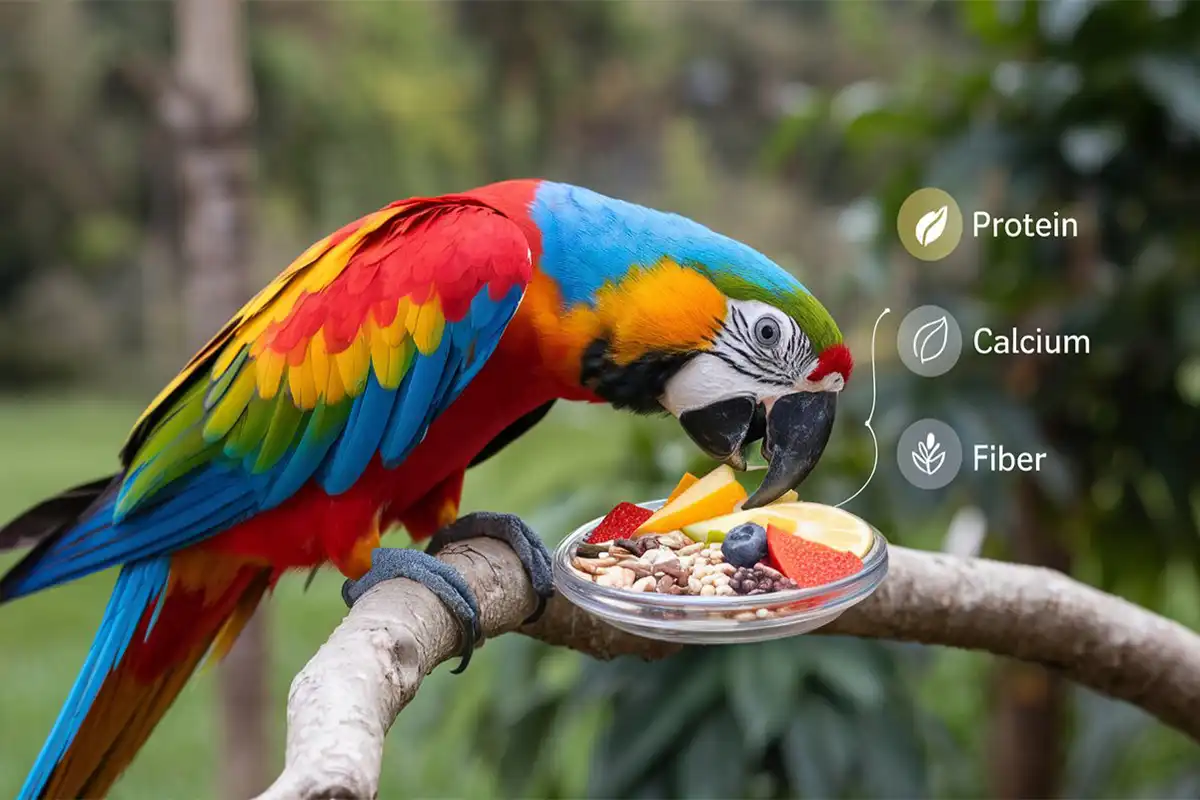
2 thoughts on “Top Parrot Food to Keep Your Pet Chirping With Joy Every Day”
Comments are closed.